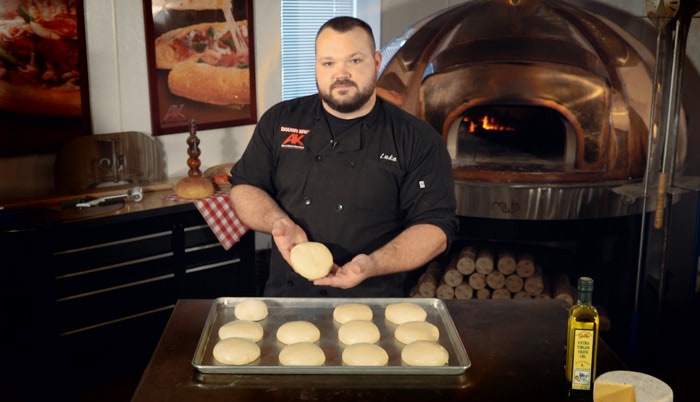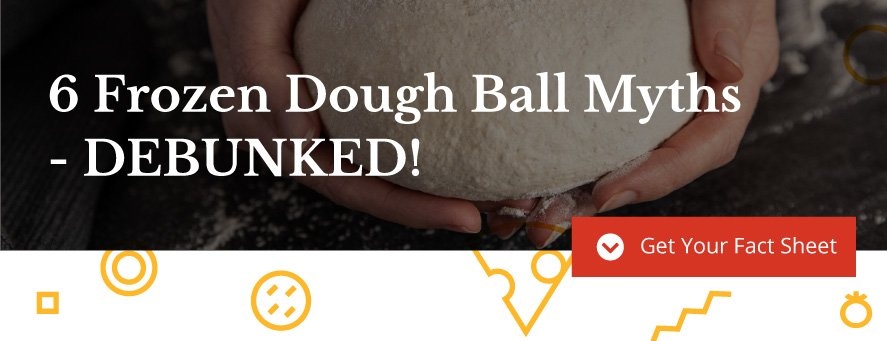
A delicious crust is the foundation of any great-tasting pizza, and the first step to a beautiful crust is properly proofed pizza dough, whether you’re using your own homemade pizza dough recipe or a frozen dough ball.
So, what happens during dough proofing, anyway, and why is it so important for achieving a crust that customers love?
Proofing activates the yeast cells in the dough recipe. The yeast “eats” the sugar in the dough, converting it into alcohol and carbon dioxide — generating the bubbles that make the dough rise and double in size. The proofing process is important not only for the structure and texture of the crust, but also for a complex, satisfying flavor that brings out the best from your sauce and toppings.
A frozen dough ball is much simpler to proof than homemade pizza dough, which includes bulk fermentation, cooling, and final proofing steps. With frozen dough, you only need to ensure the right tools, temperature, and time, and keep an eye on color and size as the dough thaws and proofs — improving your kitchen’s efficiency.
Chef Luke from Alive & Kickin’ Pizza Crust is here with five helpful tips on properly proofing pizza dough:
TRANSCRIPT — Perfectly Proofed Pizza Dough
Properly proofing dough is probably the most important thing you can do to ensure pizza quality, and the process is easy when you follow these tips:
Color should be yellow, not gray or white. When frozen, dough balls are fairly white with perhaps a little off-white mottling. Proper proofing will result in dough that’s yellow in color. Under-proofed dough will be a shade of white that’s close to the color when frozen. Over-proofed dough will appear gray instead of yellow.
Proofed size is 1.5 to 2x larger than the frozen dough ball. A frozen dough ball is fairly small.When proofed, it should expand to double in size from its original, frozen state.
Proof for a minimum of 24 hours. You can get by with thawing and proofing your dough for a 24-hour period, but 48 hours is better and 72 hours (three days) is ideal. Since yeast is a living organism, dough balls are good for about five days from the time you pull them out of the freezer until the yeast is spent and no longer working. Spent yeast will compromise dough proofing and rise, since the yeast activity won’t be reliable.
Use a sheet pan and speed rack. The best option is to proof your dough balls on a sheet pan and place the pans on a speed or bakers rack.
Some people use dough trays or red, white or green fiberglass dough totes. Trays and totes work, but they are not consistently open all the way across the tray, and that can impact the proofing process. When the dough is placed in totes, stacked and put into the refrigerator, the expectation is that the dough will be ready in a day — but it’s not true. Most of the time the top layer of dough balls will be well proofed, and the bottom layers will be practically frozen.
You need as much even airflow as possible for proofing, which makes using a bakery-style sheet pan and speed rack your best bet.
Maintain a 34°–40°F proofing temperature. Ideal proofing temperature range is 34°–40°F. Anything under 34°F and the dough won't thaw enough to actually be proofed; over 40°F could raise health department concerns over food safety.
The Consequences of Over- or Under-Proofed Dough
Under-proofed dough won’t brown properly or crisp up. It will also be extremely bubbly in the oven, so you’ll have to constantly watch it and pop all of the bubbles while it’s cooking. Over-proofed dough tastes good and will get crispy; however, it will be flat and lifeless. There’s far less lift in the pizza because the yeast is spent.
Establishing and following best practices for dough proofing is the best way to achieve consistently flavorful, perfectly risen crust — and reliably top-quality pizza. Frozen dough balls make that consistent quality easier and faster, and can even save your operation money in the process.
Learn more about the benefits — and get proof to debunk the myths about frozen dough balls when you download our guide, 6 Frozen Dough Ball Myths Pizzeria Operators (Probably) Believe. Click the link below to download your copy.





